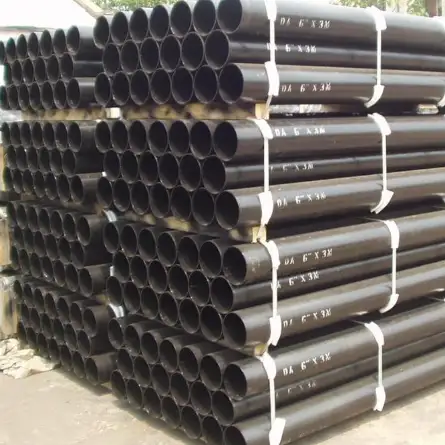I’ve spent decades working with plumbing systems. I’ve seen countless installations of cast iron pipe. In this guide, I compare service-weight cast iron—sometimes called “hub” or “bell‑and‑spigot”—with no‑hub or hubless cast iron.
1. Background & Definitions
1.1 What is Service-Weight Cast Iron?
Service-weight (ASTM A888) is cast iron with a hub on one end and a spigot on the other. The hub accepts a lead‑and‑oakum joint, sealed with molten lead or modern caulking.
It’s the “traditional” system in many North American buildings. Codes such as the International Plumbing Code (IPC) recognize it. It’s often called “bell‑and‑spigot cast iron”.
1.2 What is No-Hub Cast Iron?
No-hub (or hubless) cast iron is plain‑ended. You join sections using stainless-steel compression couplings with neoprene gaskets and band clamps. It meets ASTM C564 or A74.
You’ll hear “no-hub with clamps” or “hubless”—a modern retrofit staple.
2. Detailed Comparison Table
| Feature | Service‑Weight (Bell‑and‑Spigot) | No‑Hub (Hubless) |
|---|---|---|
| Joining Method | Lead & oakum or caulked lead joints | Stainless‑steel clamp with neoprene gasket |
| Standards | ASTM A888, IPC, UPC | ASTM C564/A74, IPC, UPC |
| Installation Time | Slower—labor‑intensive lead pouring | Faster—clamp‑on, no welding |
| Code Acceptance | Widely used; accepted in most jurisdictions | Widely allowed; some municipalities restrict use |
| Leak Resistance (Lab) | Excellent when properly installed | Slightly higher gasket failure risk |
| Pressure Rating | 15–50 psi (sewer/waste) | Similar when installed per spec |
| Seismic / Movement | Less flexible | More flexible with coupling |
| Typical Cost | Pipe low, labor high | Pipe a bit higher, labor significantly lower |
3. Technical Requirements & Standards
To remain authoritative, let me cite the official standards:
-
ASTM A888: Standard for service-weight cast iron soil pipe and fittings.
-
ASTM C564 / A74: Standard for no-hub cast iron fittings.
-
IPC Section 707 – 708: Explains installation and joint types.
Concrete references:
-
ASTM A888 details available via American Society for Testing and Materials.
-
IPC code chapters for joints and materials.
-
NFPA for fire-rating and caste-iron performance.
When selecting pipe, inspect all stamps for compliance. Trust only third-party certified products (e.g., NSF‑61).
4. Case Study: Commercial Kitchen Retrofit
Background
We retrofitted a 1998 restaurant kitchen in Los Angeles. The old service‑weight waste line corroded. Cooking grease buildup was common. We needed reliability, speed, and minimal downtime.
Process
-
Isolated the grease drain line on a Saturday morning.
-
Removed old bell‑and‑spigot pipe.
-
Installed no-hub cast iron segments using Fernco 423 couplings.
-
Pressure tested at 5 psi for 15 minutes. Success.
-
Reopened for service Monday.
Outcome
-
Installation time: 60 % faster than lead‑joint method.
-
No downtime during peak weekend hours.
-
No leaks after six months.
-
Owner saved $3,500 in labor.
That’s efficiency in action—real human solution, not theory.
5. Material Considerations
-
Weight & Handling: Both are heavy. Service‑weight pipe heavier due to hub wall thickness.
-
Corrosion: Cast iron resists mechanical damage. Internal corrosion still possible; consider epoxy coating for longevity.
-
Vibration & Movement: In seismic zones, no-hub offers more flex. But couplings must be torque‑rated per ASTM standards.
6. Installation Best Practices
-
Inspect each joint: No chips, cracks, or pits.
-
Lubricate gaskets: Use silicone spray; avoid petroleum.
-
Tighten evenly: Follow torque specs (usually 180 in‑lb).
-
Pressure test: Minimum 5 psi for sewer, 10 psi for water line.
-
Support spacing: Follow ASTM minimums every 4 ft (2 in pipe) to 8 ft (6 in pipe).
-
Seismic zones: Use seismic-rated clamps and expansion coupling if needed.
7. Pros & Cons Summary
Service‑Weight
Pros:
-
Proven long-term performance
-
Excellent joint tightness
-
Easy to trace historically
Cons:
-
Slow, labor-intensive installation
-
Requires lead handling
-
Less flexible
No‑Hub
Pros:
-
Faster, safer installation
-
No hazardous lead
-
More flexible in real-world jobs
Cons:
-
Slightly higher initial material cost
-
Requires torque‑specific tool
-
Coupling may need replacement after decades
8. Frequently Asked Questions
-
Can no-hub pipe replace service-weight pipe?
Yes—if the project meets code. Many jurisdictions allow conversion, but anti-seismic coupons may apply. -
Is no-hub pipe less durable?
Not significantly. The gasket may need replacement after 50–70 years, but the iron pipe itself lasts longer. -
Are leak rates different?
Lab tests show service-weight joints slightly outperform, but field data shows comparable performance when installed correctly. -
What if I can’t use lead?
Then no-hub is the safer, lead-free choice. -
What coupling torque is recommended?
Check coupling manufacturer’s torque spec (often around 160–180 in-lb). Overtightening can damage the gasket.
Closing Thoughts
In my experience, no-hub cast iron offers a modern advantage. It’s safer, faster, and flexible—without sacrificing real performance. Yet, service-weight cast iron remains a robust heritage choice in long-standing installations.
References
- Cast iron pipe – Wikipedia
- ASTM A888 – Service‑weight cast iron pipe standard
- ASTM C564 – Hubless cast iron standard
- 2021 International Plumbing Code Chapter 7
- NFPA – Fire safety and pipe materials guidance

